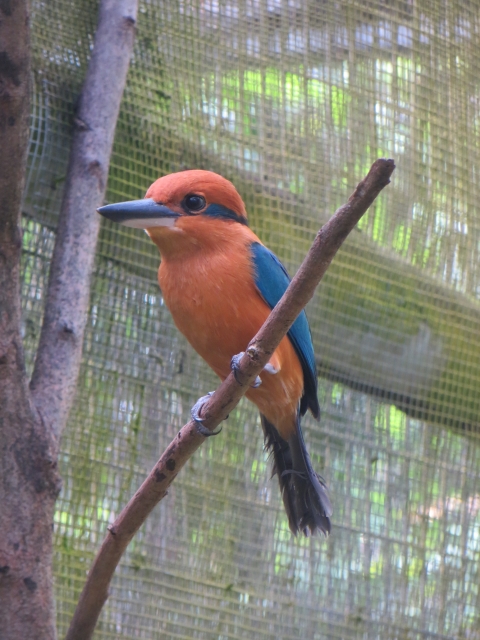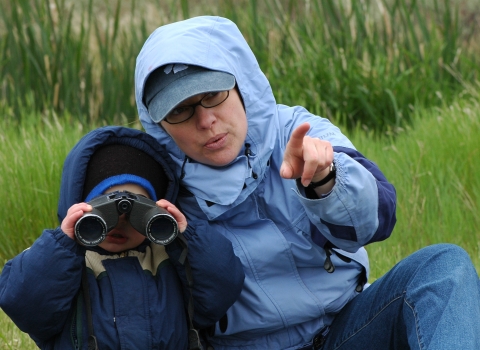This year is the 50th anniversary of the Endangered Species Act, a law that has been a powerful catalyst for conservation of America’s most treasured fish, wildlife, plants and their habitats. In the Pacific Region, our Tribes, state and federal agencies, and partners have joined with our dedicated staff to be the driving force behind the successes we share and the strength ensuring we can address the challenges ahead. Celebrate this milestone with us in this collection of stories as we reflect on past successes, assess current challenges, and envision an equally bright future for the next 50 years and beyond.
Scientific Name: Todiramphus cinnamominus
Chamorro Name: Sihek
Common name: Guam Kingfisher
Status: Extinct in the Wild
The sihek is endemic to the forest of Guam. Visually striking in appearance, its head and chest is adorned with cinnamon-orange feathers, while bright blue metallic feathers cover its wings and tail. A black streak dashes across its eyes towards the back of its head. Once found throughout Guam, sihek was declared extinct in the wild around 1988 due to the accidental introduction of the predatory brown treesnake (Boiga irregularis).
In 1983, the Guam Bird Rescue Project was initiated by the Association of Zoos & Aquariums in response to the decline of Guam’s native birds. Twenty-nine sihek were brought into captivity by 1988. Today an estimated 152 sihek are being cared for in 25 zoos in the continental United States and at a Guam Department of Agriculture facility.
In Chamorro Culture
Chamorro stories were passed down orally throughout the centuries. Some stories were cautionary tales that warned people of the dangers that came with being greedy or prideful. Other stories inspired people to embrace their imperfections and dare to be better. However, almost all Chamorro stories were inspired by the land, fish, and animals that surrounded them.
One Chamorro story recalls Guam’s forest being filled with the songs of forest birds. Among that chorus was the song of the sihek, that was so loud that it could be heard from great distances and those who followed it would get lost in the forest. According to the story, the sihek was once a village woman who wore an orange handkerchief and a blue dress with a white apron. She always loved to talk loudly and cause trouble for the other villagers. However, one day a taotaomo’na (ancestral spirit) became angry with her and turned her into the first sihek, with her clothes becoming the bright feathers of the bird. From that day forward, the unhappy bird would call loudly when people were near.
Habitat and Range
Sihek could be found across the island’s different ecosystems, from limestone forest to coastal lowlands, favoring to nest within the woodlands due to its rich food source and mature trees for nest sites. Records of distribution suggest sihek maintained year-round territories. The Micronesian kingfisher (Todiramphus reichenbachii), a genetic relative of sihek, demonstrates an average territory size of 20 acres with fledglings observed establishing new territories approximately 4,500 feet from their original homes.
Diet and Life Cycle
Sihek have a long, heavy bill which indicates its predatory feeding behavior, as it feeds entirely on animal prey including skinks, geckos, spiders, beetles, and land crabs. They are a “sit and wait predator” that perch motionless on exposed branches and swoops down to capture prey off the ground with their bill.
Sihek are monogamous birds that lay one or two eggs per nest. They make their nests in the trunks of soft or rotten trees where both parents will take turns incubating the eggs. Incubation and nestling periods for sihek in the wild are currently unknown, however, in captivity it can average anywhere between 22 to 33 days.
While there is little information about the lifespan of sihek in the wild, they have been known to live up to 15 to 20 years in captivity.
Threats to the Species
Sihek, like almost all of Guam’s native birds, faced an extinction crisis after the accidental introduction of the brown treesnake.
Native to Indonesia, the Solomon Islands, New Guinea, and Australia, the injurious brown treesnake was first reported during the 1950s. It is widely believed that they were stowaways on cargo ships or military transports. They range in color from yellow to dark brown, have wide heads, large cat-like eyes, are venomous, nocturnal, and can grow up to 9-feet in length. On average brown treesnakes can live up to 13-years in the wild and can lay up to 12 eggs, twice per year. They primarily prey upon birds, lizards, other reptiles, and small mammals such as rats and mice.
With no natural predators on Guam, the brown treesnake is responsible for the extinction of nine of 13 native forest birds, several species of lizards, and a frequent cause of electrical power outages as they often get into transformers and electrical boxes.
Other threats to sihek likely included predation by feral cats, rats, and monitor lizards, human harassment, contaminants, and competition with invasive birds.
Reason for Hope
On April 4, 2023, the U.S. Fish and Wildlife Service finalized an experimental population designation of sihek on Palmyra Atoll. This allows for the introduction of captive reared sihek to Palmyra Atoll. Under section 10(j) of the Endangered Species Act, the experimental designation allows for the release of the at-risk species to further its conservation. Sihek fledglings will be brought to Palmyra Atoll, held in aviaries for up to a month to acclimatize to the site, and released. Palmyra Atoll is co-managed by The Nature Conservancy and the Service.
Sihek have been extinct from the wild for more than 30 years and there is much scientists don’t know about how sihek behave in the wild. The experimental population on Palmyra Atoll would allow scientist to monitor and evaluate sihek in the wild, refining techniques for future releases, with the ultimate goal of releasing sihek on Guam once the brown treesnake population can be controlled effectively. The experimental population has the potential to significantly increase the worldwide population of sihek.
###
The U.S. Fish and Wildlife Service works with others to conserve, protect, and enhance fish, wildlife, plants, and their habitats for the continuing benefit of the American people. For more information, visit www.fws.gov/pacificislands, or connect with us through any of these social media channels at https://www.facebook.com/PacificIslandsFWS, www.flickr.com/photos/usfwspacific/, https://medium.com/usfwspacificislands or www.twitter.com/USFWSPacific.







